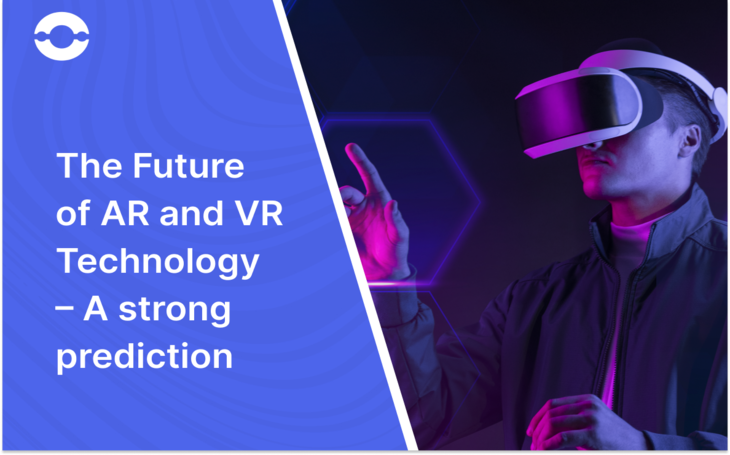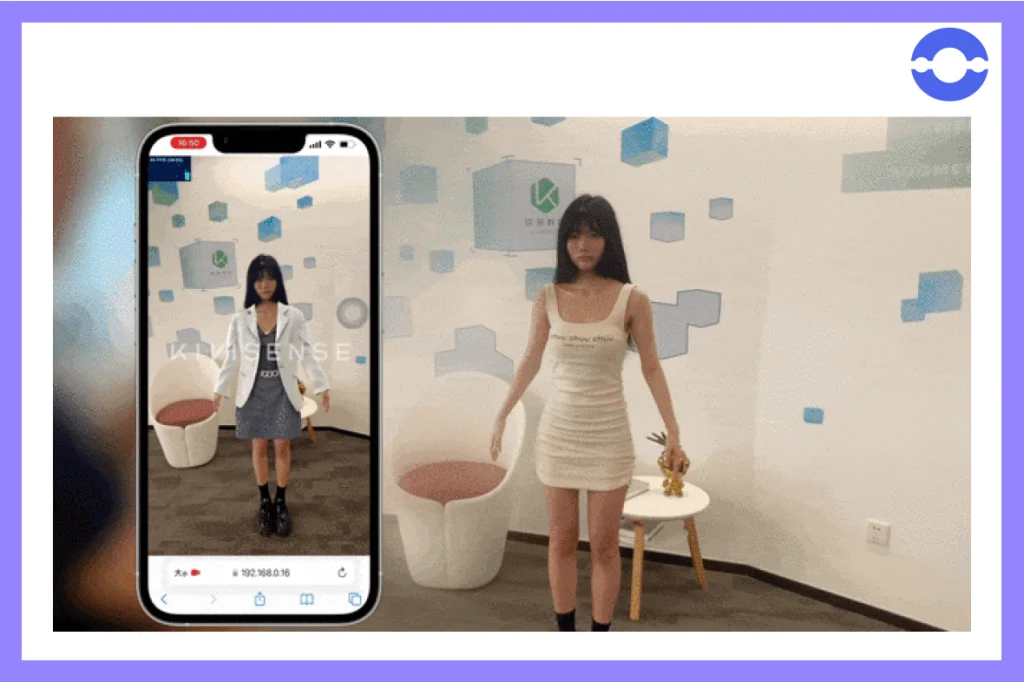
Augmented Reality and Virtual Reality brought revolutionary changes in the lives of consumers and businesses. Not only have these technologies caught the attention of smartphone users, but also, they have also touched the hearts of established brands.
Of course, AR/VR technologies are there to change the way businesses operate their processes and interact with their customers. With AR/VR technologies, customers get immersive experiences to play around in a virtual world.
In this blog, we will uncover the future of AR/VR by telling you the major AR/VR predictions you can’t ignore in 2024.
What Is AR/VR?

AR/VR has become dominant in 2023 and will continue in 2024. Augmented Reality means when the digital elements blend with the 3D virtual objects with the help of an AR device. The word augmented derives from the Latin term augment, meaning “to add.” Thus, AR focuses on enhancing the experience of the real world by adding virtual world elements.
Users can experience AR using various devices such as tablets, smart glasses, headsets, etc. Unlike Virtual Reality, AR does not try to cut the real-world environment; rather, it focuses on enhancing the beauty of the real world using computer-generated images.
Augmented Reality perfectly blends the physical and virtual world by superimposing digital images in a physical environment. Playing Pokémon GO and using Snapchat filters is one of the popular examples of AR technology.
While VR is about replacing the physical world with the virtual world using specific hardware like VR headsets and Oculus Quest 2. Virtual Reality is bringing a huge revolution in every sector, primarily the gaming and entertainment sectors, enabling users to immerse themselves in the simulated environment fully.
Hence, Virtual Reality provides a novel experience to the users as users not only view the 3D world but are also fully immersed inside the 3D world.
Predictions For The Future Of AR/VR
Augmented Reality and Virtual Reality have a bright and promising future; it’s expected to grow and take up a major share of the market driven by lower costs as lightweight devices are coming into the market.
Let’s reveal them one by one!
Major Predictions For VR In 2024
Here are some major predictions for VR in 2024-
1. VR Headsets Are Going To Be Smaller And Lighter
VR headsets provide immersive experiences to the users to feel the presence of the virtual world and get them fully involved in it. The size of VR headsets is becoming much smaller, and they are lighter than ever before.
Today, VR headsets are integrated with popular technologies such as hand detection and eye tracking. Hand detection technology allows users to enjoy the virtual world without relying on controllers. At the same time, eye tracking technology allows the user to focus only on that area of the image where the user wants to put more focus on.
2. XR Accessories Are Coming To Enhance User Experience.
Now, XR accessories are coming up to enhance the experience of users. A great example of this would be robotic boots. A tech startup, “Ekto VR,” introduced Ekto One Boot, wherein Ekto Boots allowed the players to walk and move without leaving their playspace. These boots have roller skates that keep moving by syncing with the wearer’s direction.

Thus, users can experience the virtual world by using boot abilities to be able to walk naturally on the device.
3. VR avatars
VR technology was already exciting, but the integration of VR avatars in virtual events and concerts brings immersive digital experiences.
Imagine avatars behaving like a real human being and mimicking human expressions, promptly responding to other questions, and attending virtual meetings.
These virtual representatives can do anything that a normal human being can do.
A perfect example of this is Meta avatars. Digital avatars in meta can interact with each other, hop on video calls, express their style, and update their looks. They can be actively involved in virtual concerts, attend social events and gatherings, and go out to a magical landscape.
4. VR Acts As A Tool For Remote Education.
Now, geography and science lessons have come live. More importantly, students can perform live surgeries in virtual environments. Research studies projected that VR-based learning solutions could increase test scores by 20%.
Even the co-founder and Chief content officer of Talespin says that VR learning solutions are much more effective and efficient than traditional means of learning.
Thus, VR is majorly used in the education and learning sector due to its ability to provide immersive experiences by expanding the horizon of classrooms to different planets.
5. Remote assistance using VR
With virtual reality, remote assistance has become more engaging as it provides a space for users and support assistants to collaborate seamlessly and solve their problems. Integration of VR in different industries is a BLESSING.
For Instance – VR remote assistance can help medical professionals virtually examine patients and provide diagnoses.
While it provides various benefits in the case of IT support and maintenance. Let’s say if the IT guy is not physically present in the organization, he can still repair machine breakdowns or troubleshoot problems using VR technology.
Major Predictions For AR in 2024-
Here are the major predictions for AR in 2024-
1. AR Avatars Are Rising Steadily

Avatars are the representation of you in the real world. You might have seen a rise in the popularity of virtual influencers wherein digital identities are transferred to the virtual world. Companies like Snapchat and Instagram are allowing users to apply various AR filters.
Even business leaders and marketers are leveraging the use of AR avatars for navigation inside/outside the store which in turn enhances the overall experience. Meanwhile, Companies like Facebook and Meta are also developing avatars wherein these avatars can be used in virtual environments.
2. Web AR
Earlier users had to download mobile apps to enter the augmented Reality world. With Web AR, users can view the AR experiences right from the web of mobile devices, not necessarily the mobile apps anymore.
Now, Web AR has expanded its scope by enabling users to experience the world of AR on web browsers such as Mozilla Firefox and Google Chrome which results in easy accessibility and enhances the user experience.
In addition, Web AR proves to be good in some instances where users can change the color of objects, apply filters on faces, and even do background replacements.
For example – Volvo launched a new Volvo S60 by collaborating with Studio VZ lab. They used Web AR to promote the launch of a new car. Through a web-based AR experience, you can schedule a test drive, play with car colors, and chat with a real expert.
While Web VR stands for web-based virtual reality. Web-based VR takes the user into a virtual world where customers can go shopping inside the store as if they are physically present there.
This technology is gaining prominence in the gaming and entertainment industry. But, to get such immersive experiences, you won’t need any app. You need a headset to experience and get into that virtual world.
3. Live Stream Shopping (Try Before You Buy Solution)

The advent of livestream shopping started in China. You might have seen influencers doing livestream shopping, and indeed, it’s good as you can check out the influencers’ reviews. We know you are enjoying those experiences, but you won’t be sure whether to buy the product or not.
With AR functionality, users can solve this problem by allowing people to try on the products in real-time. Using AR live broadcast shopping, users can experience close contact store experiences, thereby reducing the risk of doing product returns.
Thus, trying solutions before you buy helps businesses and consumers as it improves the engagement rate and is likely to increase the likelihood of customers making a purchase.
4. Remote Assistance Using AR
Remote assistance is another AR trend wherein employees can collaborate virtually. Here, an expert can guide the remote user to conduct tasks using interactive AR annotations. For instance – Technicians can see onsite locations in real time using a laptop or mobile phone.
Here, employees collaborate virtually even if they are located at their remote locations without a need for them to be physically present.
According to HubSpot, earlier call center agents used to receive 50 calls/day. Customers used to call contact customer support for queries, and the customer support team suggested suitable resolutions.
However, AR remote assistance is more than that, as it combines live video streams with computer-generated images. Thus, with AR remote assistance, agents can show the customers how to fix things.
5. AR-Based Indoor Navigation

It is another emerging AR prediction that will become achievable in 2024. Just like how GPS systems are built, the software can provide exact directions to reach a hospital, shop, or another place.
Imagine a situation where AR indoor-based navigation technology assists the guests in finding a product they are looking for and guides them where to go inside and get a product or software or reach a location.
Read Also- AR Vs VR: Differentiating Augmented Reality From Virtual Reality
6. AR in the education domain
AR in education acts as a valuable tool for educators to simplify complex topics for students in the virtual world. This makes the classroom learning more interactive and more memorable.
Hence, students are more likely to engage with concepts when gamified elements are added to theoretical concepts.
A popular example of AR in education is the dinosaur 4D+ app. It is an AR app that lets students grasp information about each dinosaur by interacting with 3D dinosaurs using flashcards.
7. AR in healthcare
It’s not a sci-fi theory that AR has a huge impact on the healthcare sector. There’s no doubt that the healthcare sector has always been complex, and patients need personalized attention.
To overcome the gap, AR blends the virtual world with the physical world making it easy for surgeons to interpret medical reports faster and deliver personalized treatment plans for patients.
Also Read: AR/VR In Gaming Industry
What Is The Scope Of AR/VR In The Future?
The future of AR/VR looks bright and promising. Because of the COVID-19 pandemic, there has been an increasing adoption of AR/VR devices. AR/VR technologies are currently used in various sectors, from education to entertainment and health care.
As per the latest AR/VR market forecasts, the AR/VR industry has earned $13.8 billion in revenue and is expected to grow by $50.9 billion in 2026.
So, AR/VR devices can potentially provide customized and well-designed experiences to customers.
Maybe in the coming 3 years, you will get an option in AR glasses to turn them into a smartphone.
Of course, the way we look at AR technologies will be completely different in the following years – it might be possible that people are using AR technology to read their inboxes or taking advantage of AR glasses to browse Instagram feeds.
So, get ready to embrace such transformation in the future.
Conclusion
Now, you understand how AR/VR application development is helping millions of businesses to skyrocket their revenue. The above predictions mentioned in the blog are booming in various sectors.
Also, if unicorn brands, including Google, Microsoft, and Meta, are leveraging these trends to provide immersive experiences to their customers, why could your brand not do so?
If you want to turn your business into a profitable machine, you can connect with an AR/VR development company. At BigOhTech, you can get a myriad of benefits by working with our AR/VR professionals and unlocking your traditional and bland business by leveraging AR/VR technologies.
Need help scaling your business to the next level? Connect with our AR/VR professionals now.
FAQs
AR/VR technologies have opened various avenues in almost every sector, from entertainment to healthcare to marketing. In 2025, you can expect various innovations in the domain of AR/VR.
For Instance – Meta company will come up with smart glasses having a display in 2025 and the first AR glasses in 2027.
Additionally, these are going to be upcoming innovations in 2025-
1. The market for AR/VR is expected to reach USD 571 billion by 2025
2. AR/VR technologies are coming to your smartphone
3. Businesses can earn more money by leveraging AR/VR content
Research studies from London-based marketing and consulting firms suggest that the AR/VR market will grow by 25% in the coming years. India is set to have a great future in AR/VR technology as it has invested around $550 million in revenue in 2020 and will invest $6.5 billion in AR/VR technologies by 2023.
VR is much more expensive than AR. It is more expensive because of the cost of headsets. However, the cost of a VR headset usually depends on the model, features, and brand.
Various industries use AR/VR in their business processes, including education, retail, healthcare, manufacturing, e-commerce, etc.




